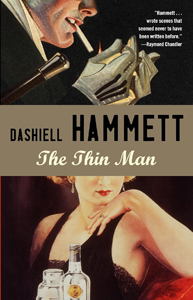I recalled “The Thin Man” (1934) being quite a bit lighter than Dashiell Hammett’s other masterpiece, “The Maltese Falcon” (1930). But on this reread the two books are so obviously written by the same author. Nick Charles is as matter-of-fact, sharp and sardonic as Sam Spade.
The protagonist is married rather than single – perhaps reflecting Hammett’s own change in status – though still appealing to every lady who crosses his path. And Nick is technically retired from sleuthing (not that he can avoid this case, as everyone keeps assuming he’s back on the beat). Those are the only major differences; Nick could easily be a slightly older, mellower, funnier Spade.
Also surprising, his wife Nora isn’t his equal as a detective. She’s like an audience surrogate, learning about the craft amid this mystery of an inventor’s murdered secretary. She is her husband’s equal in banter, though. A big part of the book’s appeal is the rhythm of their conversations, with both of them regularly making quips so fast and clever that it inspires a reader’s jealousy.

Quips and clues
The banter – made more famous in the “Thin Man” films (oddly named, since the titular character is only in this book, and – in a way – he’s not really in this book) – isn’t the whole appeal, though.
Hammett writes a helluva mystery – one that’s plausible and reflects the actual workings of a P.I. and police detectives (Nick has a mostly good relationship with Guild, who heads up the NYPD’s probe). We learn about the ins and outs of the job – particularly in a great closing chapter where Nick explains the details to Nora (and us).
Hammett illustrates how a mound of circumstantial evidence — rather than genre cliches like a smoking gun or confession — is what solves most mysteries. The author is a crisp stylist – “The Thin Man” is polished, with no wasted words and no false turns – but also as grounded as a textbook writer.
And “The Thin Man” is a compelling character piece. Oddly, it’s two side characters who stand out – young adults Dorry and Gilbert, the daughter and son of the Charles’ friend Mimi (the ex-wife of the inventor, the so-called Thin Man). Dorry is always looking to play the damsel, something that the seasoned Nick is accustomed to from sexually appealing young women; it merely amuses him 30-some years into a life on the fringes of crimes and big-city manipulations.
The socially awkward Gilbert is fascinated by Nick’s sleuthing procedures and all kinds of unusual topics, such as cannibalism in American history. Hammett includes a cannibalism tale – read by Gilbert out of a book from Nick’s library — into a brisk little horror story within the wider novel.

Wild nights in New York
It’s a strange diversion amid what’s otherwise such a tightly focused novel (yes, there are details about things like breakfast plans, but those are always sandwiched between the spouses’ chats about the mystery). It’s a backdoor way to give characterization to Gilbert and make us suspect him.
Indeed, almost everyone is a bit off, as Hammett illustrates New York society and nightlife. The Charleses (and the author himself) are on vacation in the Big Apple from their home in San Francisco.
An air of bemusement makes “The Thin Man” slightly different from “Falcon.” Friends move in and out of Nick and Nora’s hotel suite, speaking of things like ping-pong matches. And one of Nick’s speakeasy pals is someone he once put behind bars. There are no hard feelings; it’s just business, on both sides.
We come away with what feels like a true picture of New York in 1934, along with those timeless details of how cases are solved and closed.
“The Thin Man,” despite being the author’s last novel, launched a franchise; the film adaptation of this novel came out later the same year. Hammett would write two novellas for the sake of two of the sequel films. In this first novel, we begin to realize we wouldn’t mind hanging out with Nick and Nora Charles. Or merely listening in on them from the keyhole.
Sleuthing Sunday reviews the works of Agatha Christie, along with other new and old classics of the mystery genre.

